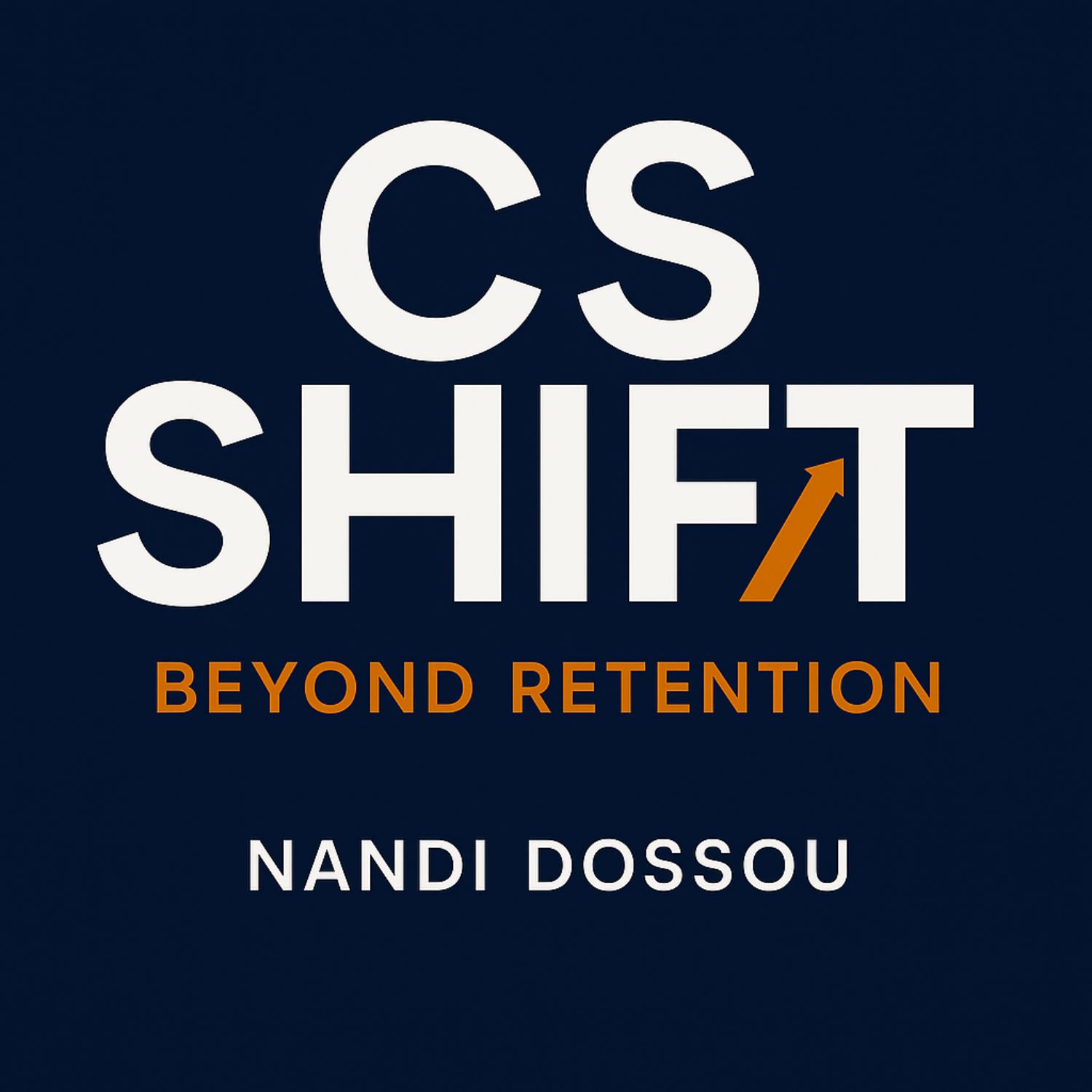Mastering Expansion: Four Indicators Every Customer Success Leader Must Know
As CS leaders, we all want growth — but let’s be honest…
By the time we talk about expansion, it’s often too late. The customer has gone cold. The opportunity has slipped.
And someone asks: “Why didn’t we see this coming?”
In this final episode of Season 1, I share:
✅ The 4 early signals of expansion readiness
✅ How to proactively surface upsell/cross-sell needs
✅ Why QBRs, champions, and usage surges matter
✅ Practical tactics for SMBs and Enterprise alike
This one is for the CS leaders who want to drive growth without sounding like Sales - and help their teams spot opportunities before someone else does.
Transcript
Welcome to CS Shift, the podcast that goes beyond retention with strategies for customer success leaders navigating the new era.
Speaker A:Let's dive into today's episode.
Speaker A:Welcome back to CS Shift, the podcast that goes beyond retention with practical strategies for customer success leaders navigating the new era.
Speaker A:I'm your host, Nandi Dosu, and today we're going to close season one with a conversation that many CS leaders avoid, which is about identifying expansion opportunities before it's too late.
Speaker A:Too often by the time we talk about growth, the customers is going cold, the window has closed, the budget has been relocated and CS gets told.
Speaker A:You should have seen this earlier.
Speaker A:So in this episode we shifting gears from reactive to proactive, from renewal focus to expansion foresight.
Speaker A:So more practically, what do I want to talk about today?
Speaker A:Well, how to identify expansion opportunities before it's too late.
Speaker A:Most CS teens don't miss expansion because of lack of effort.
Speaker A:They miss it because of lack of timing and signals.
Speaker A:You've seen it, I've seen it.
Speaker A:The customer raves in the QBR interns.
Speaker A:Two quarters later a new champion comes in and we are not looped in until the renewal.
Speaker A:A department expands, but they bring in a new vendor before we can even pitch.
Speaker A:The signs were there but none of us acted.
Speaker A:Why?
Speaker A:Because CES was trained to manage relationships, not to spot growth signals.
Speaker A:So I would like to share with you four indicators your CSMs need to spot an actor.
Speaker A:Number one, product usage surges.
Speaker A:Not just logins but depth of feature use, especially in high value modules.
Speaker A:If a team is going from 5 users to 25.
Speaker A:I even have a story about this.
Speaker A:I remember in one of the position of head of customer success I had one of my team member was working with a company and we were actually switching switching them from one solution to another.
Speaker A:And in this period they were actually using both of the solutions.
Speaker A:The goal for them was really to roll out the new solution in the next three months.
Speaker A:And then when we were discussing with them, they told us about a number of users that they thought, you know, would have used our solution.
Speaker A:And then the contract was signed.
Speaker A:Based on that, one thing is that she was not checking at all the usage of the solution that we will have decommissioned.
Speaker A:And we were preparing a QBR and I was like okay, so let's look at numbers.
Speaker A:And then by looking at the number of users in all their solutions she realized that they had 100 users more than what you know they were supposed to have.
Speaker A:So long story short, we were able to get a 50k upsell deal easy so looking at product usage, very important because sometimes behind it there is potential number two, organizational changes.
Speaker A:Any change in a customer structure is a trigger.
Speaker A:New leadership, acquisitions, budget shifts, team reorgs and you know, if your teams in your teams you are using sales Navigator, that's fantastic.
Speaker A:Otherwise one of the things I've always suggested my team to do is to really look at the news wherever they check Google News, Google mentions, really look at what's going on.
Speaker A:Even just using LinkedIn to follow companies and to follow the important people in your organization because it also help to understand things that are changing.
Speaker A:Affirmed indicator.
Speaker A:It's process expansion.
Speaker A:What is process expansion?
Speaker A:It's when you learning about how the company is structured, the different teams and departments and you realize that one of them can definitely leverage one of the solution your tool offers because that will help them actually replicate the success across the organization.
Speaker A:And then number four in terms of indicator is really advocacy and champion signals.
Speaker A:When a customer refers, offers, joins a case study or champion moves company, it's a flashing growth sign.
Speaker A:No, these customers are invested in Cary and France.
Speaker A:So what to do?
Speaker A:Well it's really asking them who else in their org could benefit like they did.
Speaker A:Definitely follow the champion because a new company could be the next logo and absolutely celebrate advocates.
Speaker A:Then strategically explore adjacent use cases.
Speaker A:Now I talk about the indicators.
Speaker A:So this is really to identify potential opportunities, potential expansion opportunities.
Speaker A:One thing I want to add here is that there are some tactics that help also suppress opportunities because we don't wait for signals, we go look for them as well.
Speaker A:So really one thing I love to do with my team is really asking them to map all our product suites with what our customers subscribe and do not subscribe to yet.
Speaker A:And then in customer conversations explore the gaps.
Speaker A:You know, how are you handling this problem today?
Speaker A:For instance, what's next for your team this quarter?
Speaker A:Have you seen how other clients are using this feature, this product we have?
Speaker A:And QBRs are not just to review the past.
Speaker A:QBRs are really to also explore future opportunities, future priorities and uncover new potential use cases.
Speaker A:So using the check ins to not only talk about what's going on, but also talk about the benefit they could have from leveraging one new feature to leverage another solution.
Speaker A:It's just about conversations because I do absolutely believe that sales comes from conversations.
Speaker A:Now if you are leading a team of customer success in the SMB space, you can use personalized mass outreach by sharing relevant product roadmap features.
Speaker A:For instance, highlight recent success stories and case studies and even extend special offers that are tied to the segment or life cycle stage.
Speaker A:Expansion starts with curiosity, visibility and timing.
Speaker A:I want to add something which is very important and tied to what I was saying earlier because we have been so used to manage relationships and not necessarily work in expansion.
Speaker A:In growing the bottom line, it's important to again know that spotting opportunities is one thing and acting on them requires skill and struct.
Speaker A:So it's also important to prepare your team.
Speaker A:Build an expansion playbook.
Speaker A:Clear steps from signal to conversation Train on objection handling help your CSMs shift from reactive to commercial without sounding salesy and clarify ownership always will lead the conversation.
Speaker A:Is it cs?
Speaker A:Is it sales or both of the teams?
Speaker A:This is not about stepping on toes, it's just about making sure you don't miss the moment.
Speaker A:I want to conclude with Always think about having a champion RADA system who is referring you who is growing fast with moving companies because that one can really add millions in expansion.
Speaker A:That being said, three things you can do this quarter review your top 10 accounts.
Speaker A:Where are the signals being missed?
Speaker A:Train your team what to spot and how to act.
Speaker A:Align with sales.
Speaker A:Define when CS leads and when sales steps in.
Speaker A:Expansion is everyone's job, but as a CS leader you set the tone.
Speaker A:Expansion is not a surprise, it's a pattern and your job is to help your team see it, unlock it and lead it.
Speaker A:This is the wrap on Season one of CS Shift.
Speaker A:We have explored the shift from adoption to growth, building high impact resilient teams, breaking silos through cross functional alignment and spotting growth before it's too late.
Speaker A:If these pizza sparked ideas, share the show with your CSPers and subscribe so you don't miss season two.
Speaker A:Until next time, I'm Nandi Desu and this is CS Shift.
Speaker A:Thank you for listening to this show.
Speaker A:Remember, the new mandate for customer success is driving growth and growth does not happen in isolation.
Speaker A:It's driven by strategic and operational leadership.
Speaker A:Subscribe and share this episode with an overseas leader ready to shift their strategy.
Speaker A:I'm Nandi Dosu and this is CS Shift.

